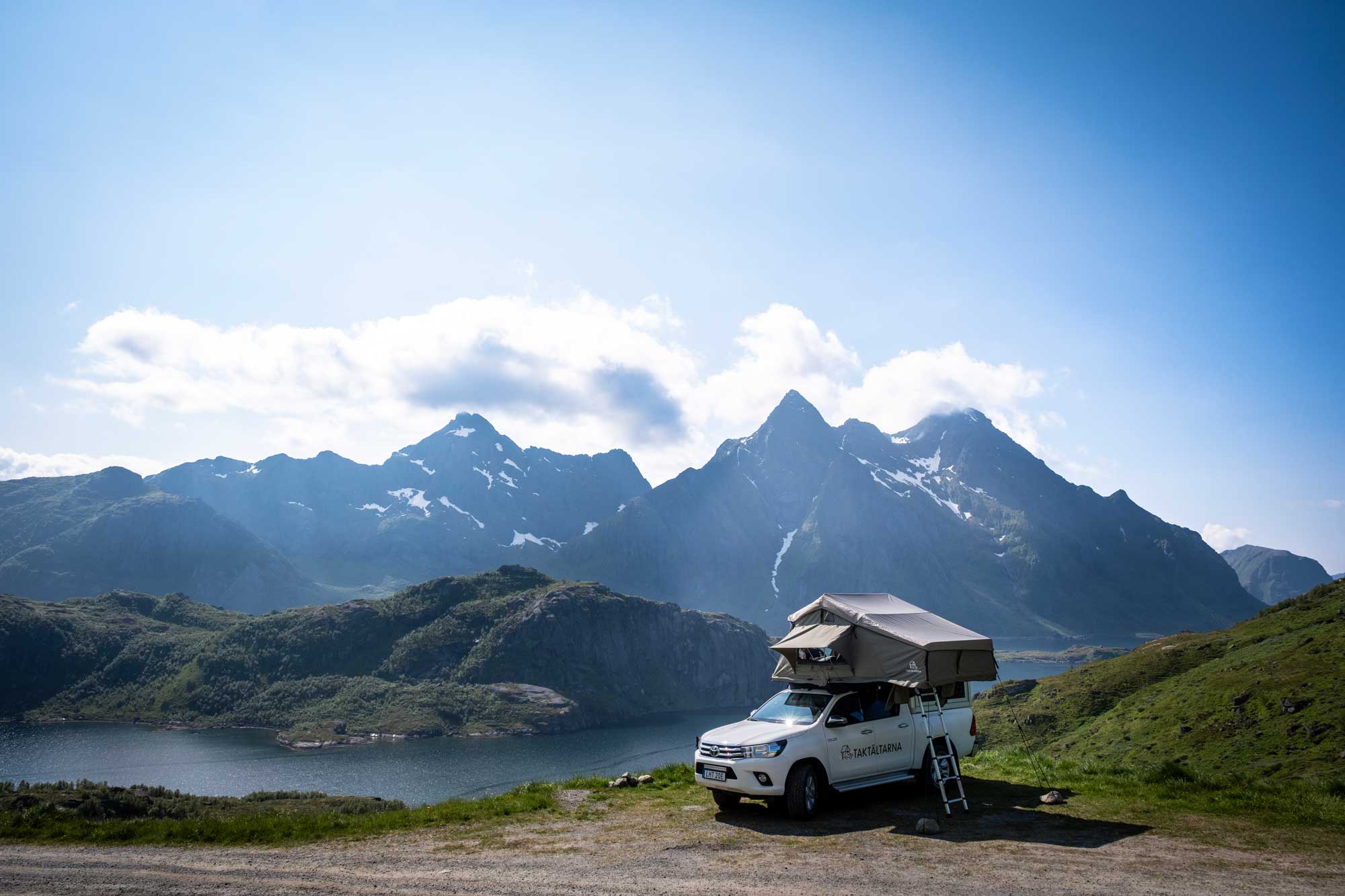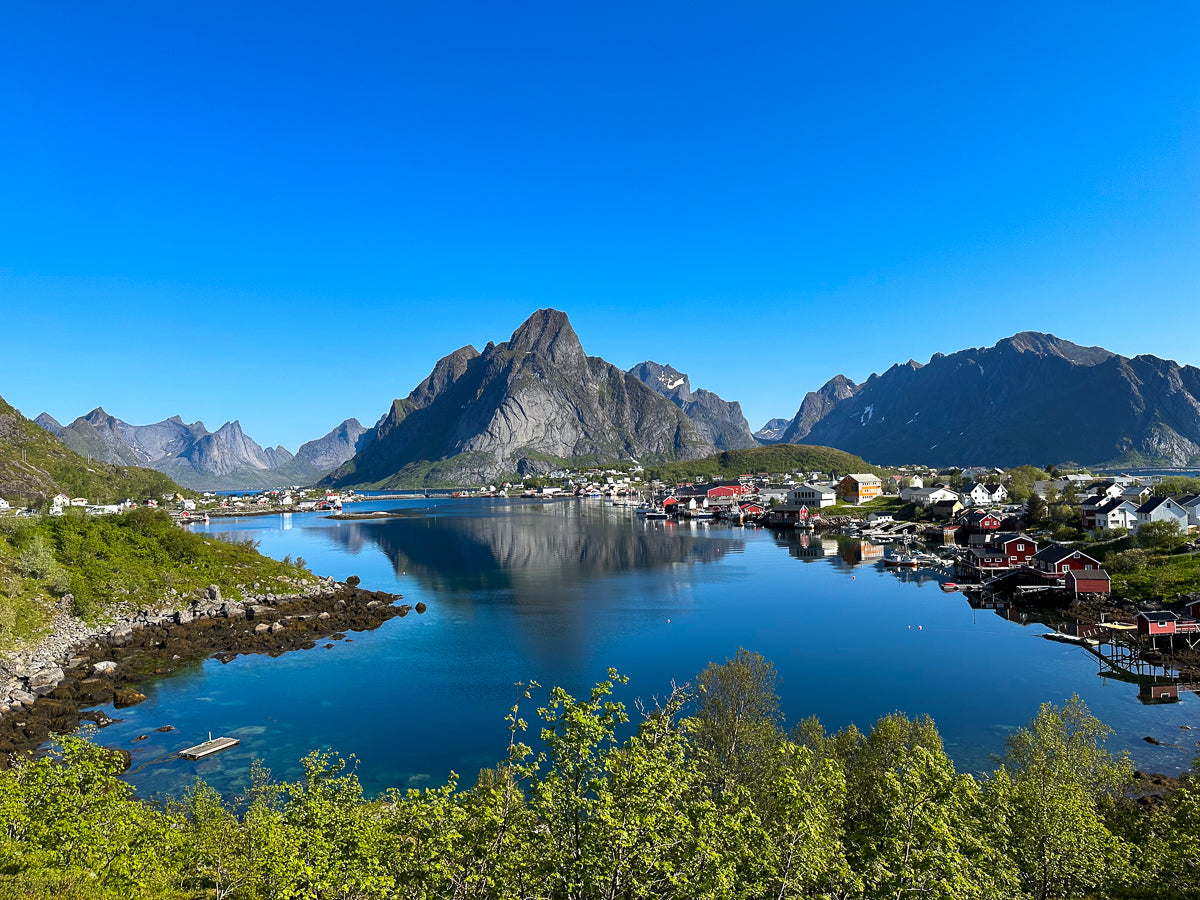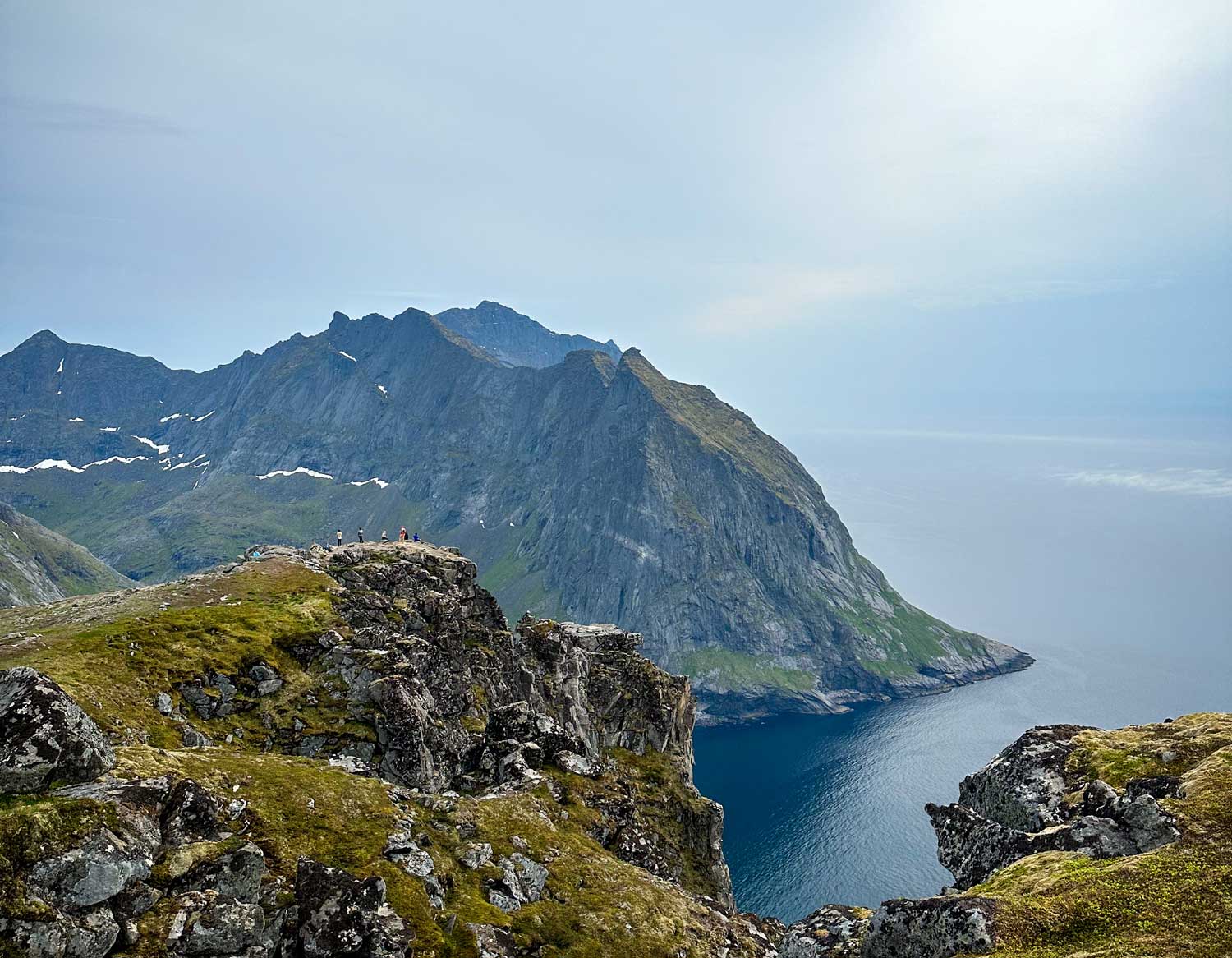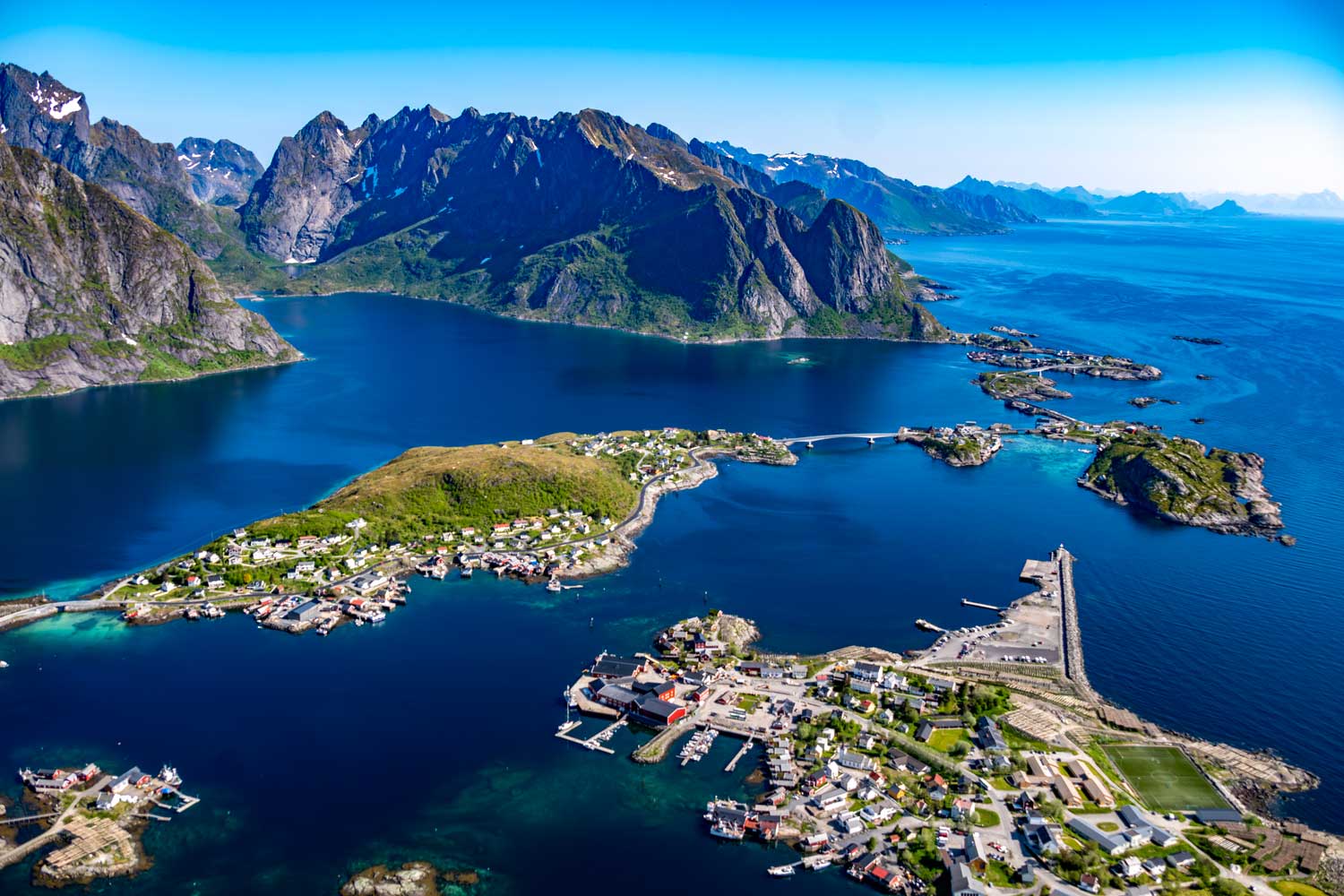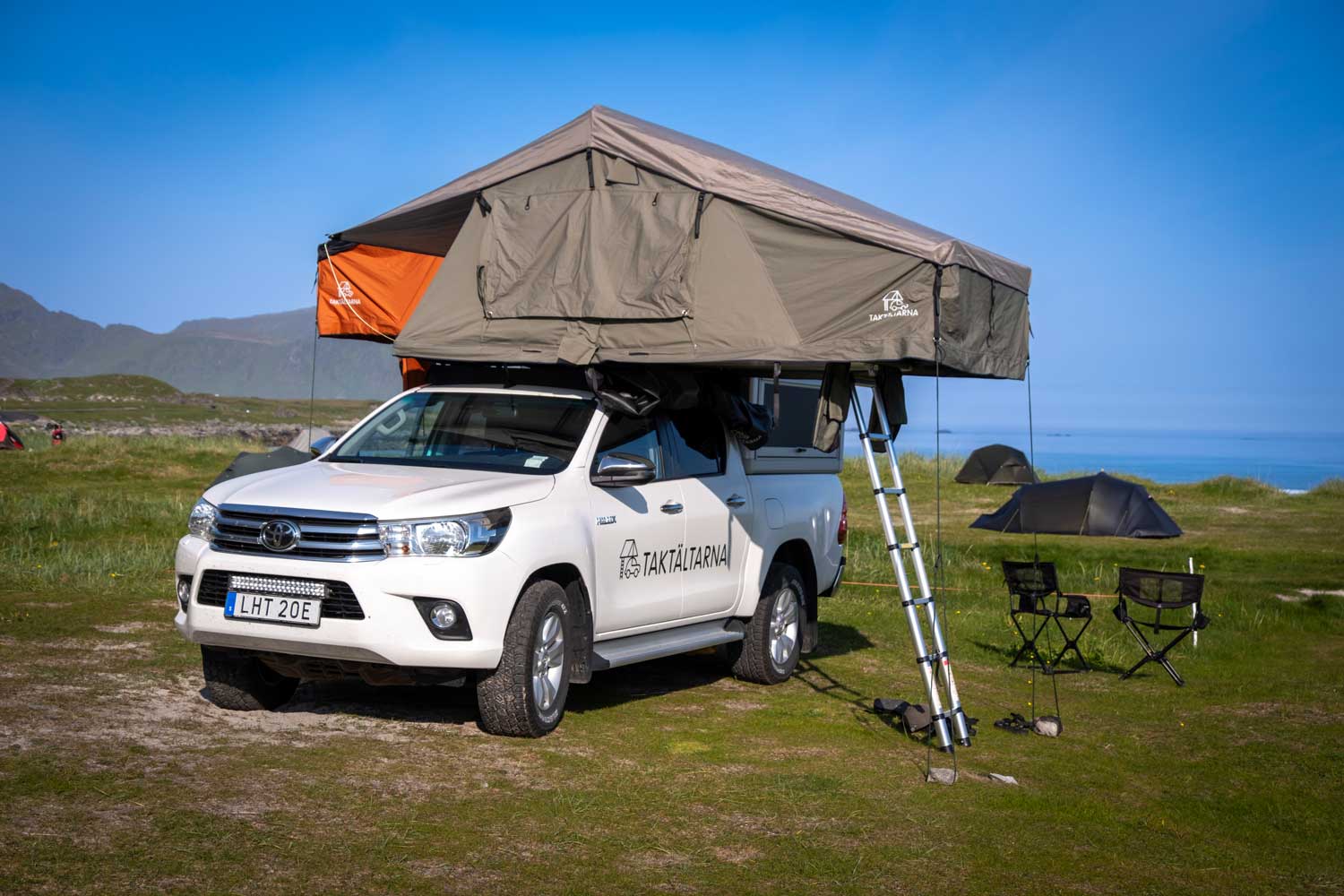Lofoten with roof tent - guide with practical advice and inspiration
Discovering the Lofoten Islands with a rooftop tent is fantastic. Outstanding scenery, plenty of beautiful campsites and scenic roads that will make you drop your jaw wherever you look. Before you set off with your roof tent to Lofoten, it's good to have a few things in mind. You get that with the help of this guide, plus lots of inspiration from our own trip!
Curious about which roof tents are in this report? The green is an Åreskutan 2.0 three-man and the orange a two-man Åreskutan 2.0 .
Lofoten is a group of islands in Northern Norway that are world-renowned for dramatic landscapes, picturesque fishing villages and outstanding opportunities for outdoor activities such as hiking, fishing, canoeing, climbing and skiing.
Getting to Lofoten often means a long journey, but once you're there, it's extremely accessible and short distances.
If you don't have the opportunity to hike, you get (almost) as wonderful nature experiences by driving around the islands.

Lofoten is named again and again as one of the world's most beautiful destinations in, among other things, travel magazines and on social media. This makes it clear that you will not be alone, especially if you go during holiday periods.
When is the best time to go to Lofoten?
The best time to go to Lofoten depends on your interests and what you want to experience during your trip. Each season has advantages and disadvantages. But one thing is certain, if you don't want to be crowded, avoid the weeks between mid-June to mid-August.
Summer is the most popular season to visit Lofoten due to warmer weather, holiday times and the midnight sun.
High season means more tourists and higher prices for accommodation and activities. Popular destinations can get crowded and campsites can be full.

We (Elisabeth, founder of Taktältarna, Björn Falkevik, photographer and Emma Almrorth, sustainability advisor) went with a roof tent to Lofoten the week before midsummer 2023. The roof tents we brought were an Åreskutan 2.0 two-man and a three-man; practical with a pickup where one fits two :).
Even though there were quite a few people, the feeling is that we just managed to be there before the biggest rush of people arrived. For example, we had not pre-booked any campsites but had no problem getting a place.
If you visit Lofoten in winter, you can instead enjoy the calm, the northern lights and fantastic off-piste skiing. My dream is probably to go back in the fall when the leaves change color. Disadvantages of autumn are shorter days and more rain than in summer.
Don't forget to bring this in your pack when you go roof tenting in Lofoten
Rainwear . We were lucky to have nice weather throughout our trip but the fact is that it rains a lot in Lofoten and the weather changes quickly.
Warm clothes . If you're lucky you won't need them, but you probably will.
Extra blanket, undershirt and hat : at night the temperature can drop significantly, make sure you have undershirt and a hat to sleep in. And an extra blanket if you have a thin blanket/sleeping bag in your roof tent.

Food . Buy what you want to take with you in the form of breakfast, dinners and snacks before you cross the Norwegian border. Bring a grill/stove and cook your own food. Overall, restaurant food in Norway is both expensive and not very good. However, there are many good restaurants on Lofoten and of course you should treat yourself to it, but maybe not every day unless your budget is unlimited.
Our dinner favourite: Buy a good Norwegian goat's cheese, cook some tortellini and sprinkle with parsley. Or if you fish - bring a rod and pull dinner straight from the sea.
Alcohol . Even more expensive than food! If you want to enjoy a beer at sunset by your rooftop tent without being ruined at Vinmonopolet, we strongly recommend a visit to Systembolaget before you cross the border.

Getting to Lofoten with a roof tent
You can get to Lofoten both by ferry from Bodö or by land up through Sweden to Kiruna and on to Narvik .
It is also possible to take the ferry from Skutvik (to Svolvær) or Bognes (to Lødingen). Check the timetables for the last two as some tours only run during the summer.

For us who live in the middle of Sweden (in Åre) it took just over 12 hours to drive to Bodö, if you live further south you need to count on two days up and two days down.
If you choose to drive the car all the way to Lofoten, you go up to Kiruna and on past beautiful Abisko, Torneträsk and Riksgränsen. But be aware that those are basically the only highlights of that route.
We chose to go into Norway directly from Åre and up to Bodö to take the ferry. Advantage: more beautiful road (the photo below was taken near Bodö). Cons: Norway's low speed limits.

If you take the ferry from Bodö you will come to Moskenes on the southern tip of Lofoten, if you take the road you will first come to the northern parts.
In general, people tend to think that it is nicer the further south you go - but honestly, we would like to emphasize that it is nice EVERYWHERE.

Do you have to book the ferry to Lofoten?
It varies depending on which ferry line you choose and the time of year you plan your trip. If you are going during high season, it may be a good idea to book well in advance as they usually get fully booked quickly.
But! Our friend who runs the hostel Furu on Lofoten told us that the ferries always have 40% of the places unbooked, so an alternative is to be there in good time (a few hours) before the ferry's departure, then there is a good chance that you will come.
When we crossed from Bodö, we chose to take the night ferry across (had not pre-booked). A big advantage of that was that we arrived at Lofoten early in the morning and had a whole day ahead of us.
There are several ferry lines that go to and from Lofoten and ferries that connect the islands within Lofoten.
Camping rules on Lofoten
Norway, just like Sweden, has public rights and it is okay to both camp with a normal tent and freecamp with a car as long as there is no camping ban and you stay at least 150 meters from the nearest accommodation.
The areas where camping is not allowed are relatively few, here you can see a map with different restrictions marked . Good to keep track of before your visit to Lofoten!
Always respect the rules that apply, take care of your rubbish and always leave the place as it was (or even better) than it was before you got there.
This is how the Lofoten tourist organization summarizes it:
Our roof tent pitches on Lofoten
When you go to Lofoten with a roof tent, it is good to be aware that it will most likely be difficult to find roof tent sites where you are completely alone. But of course it works!
And if nothing else, there are lots of nice campsites and parking pockets along the roads.
Regardless of whether you intend to stay at a campsite or find a parking pocket/pit, it's good not to be out too late. During high season it can be full.
At the campsites we stayed at, a car with a roof tent was counted as a "campervan", which was in the price range between a normal tent and a mobile home. We paid SEK 300-400/night.

Our favorite campsite during the trip was Lofoten Beach Camping . It is close to both Kvalvika Berach , Ryten and Reinebringen which we strongly recommend you to visit/hike to.
As the name suggests, the campsite focuses on surfing and holds regular surfing lessons. It is right next to a long sandy beach with beautiful mountains in the background.

We got a place very close to the beach where there was also a fireplace. The campsite also has nice newly built facilities and a restaurant with good beer and a large patio.
Of course we brought our portable sauna tent and took the opportunity to carry it down to the beach for a magical sauna experience!

We found one of our best roof tent spots at Unstad Beach . Here there are pitches near the service building but also 3-4 pitches right next to the shoreline. When we arrived, it felt a bit like we had ended up in paradise.
The steps unfolded right where the beach began, it was sunny and windless, behind us we had Unstad's beautiful valley with meadows filled with buttercups, surrounded by beautiful mountains.
Also, there was a fireplace for our place, so luxurious. The downside – no toilets (unless you can't bear to go to the service center a few kilometers further).

Before you get to Unstad beach, there are also a couple of incredibly nice opportunities for fricamping . One is a small parking pocket high up with an incredible view (photo below).
If you continue the road a little further, you will come up to another place where you have a view of Unstad Beach and the valley. There were several campervans here when we went up and checked, so we took the parking pocket!

Our best experiences on Lofoten
We tented on the roof for five days on Lofoten, that was the shortest time. We and strongly recommend that you who want to go there and roof tent have at least that, preferably more. There is simply so much to see and do, we wish we had more time.
And since it takes a long time to get there by car (for those of us who live in Åre, a day up and a day down), you want to have time once you're there.

On these days we managed three hikes: Reinebringen (photo above), Kvalvika beach-Ryten and Festvågtind . Hiking in Lofoten is STEEP, but you rarely have to go very far to reach wonderful views.
Reinebringen, for example, is just a little over a kilometer's hike, but demanding as there are many meters of altitude. However, the hike now consists more of stable stairs up (built by Sherpas from Nepal!) so it is in a way easier.

Festvågtind was just as steep but without stairs! Instead, more half-climbing, loose rocks and gravel. For the person in our party who is afraid of heights, this was a real challenge.
Halfway up we were rewarded with a beautiful mountain lake, which we of course took a swim in. Up at the top the view was (of course) absolutely incredible, the visibility was clear and we could see miles and miles of Lofoten mountain peaks plus the cute little village of Henningsvaer far below us .

The hike to Kvalvika was the easiest, not steep and not very long. We prepared lunch on the beach and then chose to continue up Ryten, one of the peaks next to the beach. Quite uphill but not as steep as the previous two.
Still incredible views and when we got to the top we were completely alone (this was around 6 in the evening).
 We visited the cute villages of Reine, Haenningsvaer and Svolvaer as well as the Lofotr Viking Museum . The latter is a must-visit for anyone interested in history in the slightest.
We visited the cute villages of Reine, Haenningsvaer and Svolvaer as well as the Lofotr Viking Museum . The latter is a must-visit for anyone interested in history in the slightest.
Here they have built a replica of a large Chief's House (the largest found in Norway) which was built on that very spot around the year 500. There is also a museum here with findings from the archaeological excavation. Incredibly exciting!

We also want to recommend the restaurant/club Traevarefabriken in Henningsvaer. Concerts, music clubs and more are arranged here.
We went there to listen to a surf band that was going to play - when we got there it unfortunately turned out to be cancelled. But just the venue and the good pizzas were enough to make it well worth a visit.
On the last day we went on a whale safari in Andenes and got to see both sperm whales and killer whales, so MIGHTY, a memory for life. Before the boat trip, we also got a guided tour of the museum in the main building.

Andenes is north of Lofoten, it took us about three hours to drive there. There are both significantly fewer people and mountains here than in Lofoten.
Map with roof tent pitches, hikes and activities on Lofoten
Fancy roof tenting at some of the spots we found? Or maybe you want to do one of the hikes we did.
Here you will find a map with all our places marked (plus some we were tipped about but didn't have time to visit ourselves). Enjoy!


